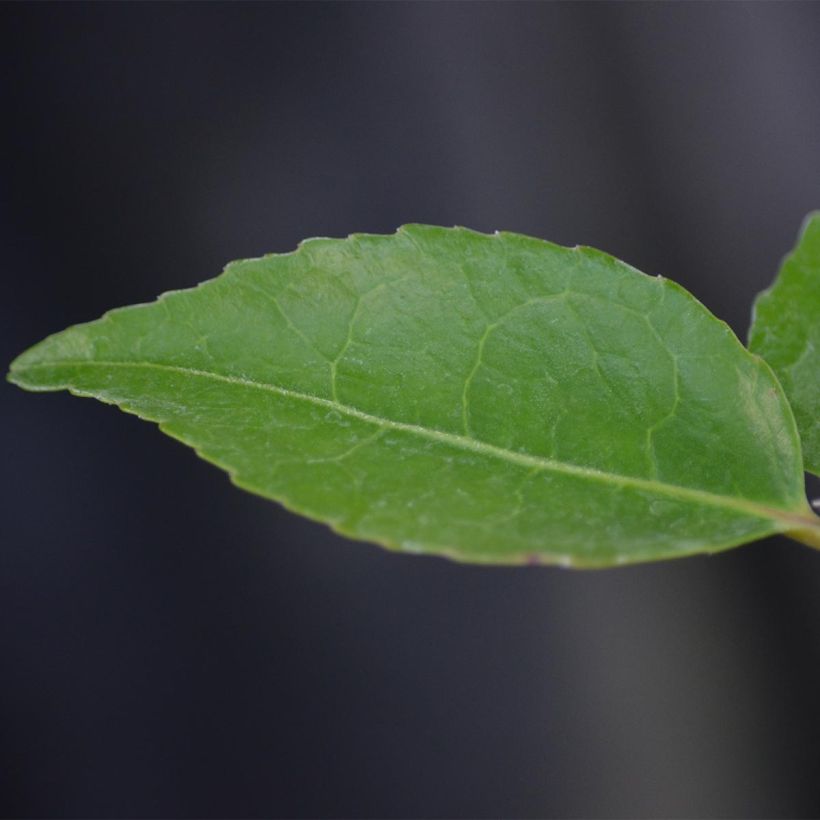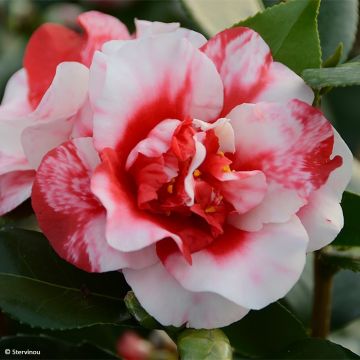

Camellia lutchuensis High Fragrance


Camellia lutchuensis High Fragrance
Camellia lutchuensis High Fragrance
Camellia x lutchuensis High Fragrance
The camellia stayed for 2 days while waiting for me to pick it up. In perfect condition and in bud!! I planted it right away and watered it with the sunshine of these past few days, and now I'm eagerly watching for the flowering. Thank you!
Solstice, 02/04/2025
Special offer!
Receive a €20 voucher for any order over €90 (excluding delivery costs, credit notes, and plastic-free options)!
1- Add your favorite plants to your cart.
2- Once you have reached €90, confirm your order (you can even choose the delivery date!).
3- As soon as your order is shipped, you will receive an email containing your voucher code, valid for 3 months (90 days).
Your voucher is unique and can only be used once, for any order with a minimum value of €20, excluding delivery costs.
Can be combined with other current offers, non-divisible and non-refundable.
Home or relay delivery (depending on size and destination)
Schedule delivery date,
and select date in basket
This plant carries a 24 months recovery warranty
More information
We guarantee the quality of our plants for a full growing cycle, and will replace at our expense any plant that fails to recover under normal climatic and planting conditions.

Would this plant suit my garden?
Set up your Plantfit profile →
Description
Camellia 'High Fragrance' is perhaps the most fragrant of field camellias. This superb New Zealand creation stands out for the magnificent scent exuded by its large double flowers, whose shape resembles that of certain peonies. Their very soft, pale pink colour is subtly enhanced by a pink blush on the edges of the petals and warmed by a salmon-coloured heart around the golden stamens. They bloom from February to April on a dense and upright bush dressed in evergreen olive green foliage that remains decorative all year round. This variety will be superb in a natural hedge or in a large container on the terrace! Give it a fresh but well-drained, non-chalky soil and a partially shaded site.
Derived from cross-breeding, field camellias belong to the family of Theaceae, like the tea plant (Camellia sinensis). They are compact shrubs with evergreen foliage that bloom from January to April depending on the varieties. Less sophisticated than their close relative Camellia japonica, they easily earn their place in a small hedge or ericaceous flower bed. They are suited to an oceanic, mild and humid climate, and non-calcareous soils.
The 'High Fragrance' cultivar, introduced in New Zealand in 1985, is the result of a cross between the variety 'Bertha Harms' and a 'child' of 'Salab' and 'Scentuous'. Its habit is free, rather upright, bushy, and dense, and its growth is rather fast for a camellia. It forms a bush 1.50 m (5 ft) tall by 1 m (3 ft) wide on average by the age of 10. This variety blooms as early as February until April. It produces a large quantity of slightly ruffled cup-shaped flowers measuring 9-10 cm (3-4 in) wide by 6.5 cm (2.6 in) deep. Their colour is a blend of white-pink, pink, and salmon-pink. The centre of the flower reveals stamens with golden anthers. Their powerful fragrance evokes that of the botanical Camellia lutchuensis.
At budburst, the young leaves are coppery and gradually turn to a fairly light olive green, slightly shiny. Oval in shape, they measure 7.5 cm (3 in) in length by 4.5 cm (2 in) in width and have serrated edges. Hardy down to -14°C, this variety is grown in partial shade, sheltered from cold winds.
Plant Camellia High Fragrance in an ericaceous flowerbed alongside Japanese or deciduous azaleas, skimmia, Japanese quince, and heathers, and plant bulbs such as tulips and daffodils at their feet in autumn to create a colourful scene in spring. The compact size of this variety is also suitable for container cultivation: to fully enjoy its fragrance, place your High Fragrance camellia on a partially shaded terrace, alongside a wall not far from the house, protected from cold and drying winds.
Our field camellias are 4 years old. They will bloom from the 5th year onwards.
Report an error about the product description
Camellia lutchuensis High Fragrance in pictures




Plant habit
Flowering
Foliage
Botanical data
Camellia
x lutchuensis
High Fragrance
Theaceae
Cultivar or hybrid
Other Traditional Camellia
View all →Planting and care
Place Camellia High Fragrance in a fairly shaded area sheltered from cold and drying winds. You can grow it in full sun but the roots need to stay cool. Plant it in a fresh, humus-rich, acidic and well-drained soil. Do not plant the bush too deeply; cover the top of the root ball with 3 cm (1.2 in) of soil. In winter, cover it with a 5 to 7 cm (2 to 3 in) thick mulch composed of leaf compost and crushed bark. Beware of late frosts that can damage the flowers and buds. Water during dry periods to prevent the bush dropping flower buds.
Planting period
Intended location
Care
-
, onOrder confirmed
Reply from on Promesse de fleurs
Similar products
Haven't found what you were looking for?
Hardiness is the lowest winter temperature a plant can endure without suffering serious damage or even dying. However, hardiness is affected by location (a sheltered area, such as a patio), protection (winter cover) and soil type (hardiness is improved by well-drained soil).

Photo Sharing Terms & Conditions
In order to encourage gardeners to interact and share their experiences, Promesse de fleurs offers various media enabling content to be uploaded onto its Site - in particular via the ‘Photo sharing’ module.
The User agrees to refrain from:
- Posting any content that is illegal, prejudicial, insulting, racist, inciteful to hatred, revisionist, contrary to public decency, that infringes on privacy or on the privacy rights of third parties, in particular the publicity rights of persons and goods, intellectual property rights, or the right to privacy.
- Submitting content on behalf of a third party;
- Impersonate the identity of a third party and/or publish any personal information about a third party;
In general, the User undertakes to refrain from any unethical behaviour.
All Content (in particular text, comments, files, images, photos, videos, creative works, etc.), which may be subject to property or intellectual property rights, image or other private rights, shall remain the property of the User, subject to the limited rights granted by the terms of the licence granted by Promesse de fleurs as stated below. Users are at liberty to publish or not to publish such Content on the Site, notably via the ‘Photo Sharing’ facility, and accept that this Content shall be made public and freely accessible, notably on the Internet.
Users further acknowledge, undertake to have ,and guarantee that they hold all necessary rights and permissions to publish such material on the Site, in particular with regard to the legislation in force pertaining to any privacy, property, intellectual property, image, or contractual rights, or rights of any other nature. By publishing such Content on the Site, Users acknowledge accepting full liability as publishers of the Content within the meaning of the law, and grant Promesse de fleurs, free of charge, an inclusive, worldwide licence for the said Content for the entire duration of its publication, including all reproduction, representation, up/downloading, displaying, performing, transmission, and storage rights.
Users also grant permission for their name to be linked to the Content and accept that this link may not always be made available.
By engaging in posting material, Users consent to their Content becoming automatically accessible on the Internet, in particular on other sites and/or blogs and/or web pages of the Promesse de fleurs site, including in particular social pages and the Promesse de fleurs catalogue.
Users may secure the removal of entrusted content free of charge by issuing a simple request via our contact form.
The flowering period indicated on our website applies to countries and regions located in USDA zone 8 (France, the United Kingdom, Ireland, the Netherlands, etc.)
It will vary according to where you live:
- In zones 9 to 10 (Italy, Spain, Greece, etc.), flowering will occur about 2 to 4 weeks earlier.
- In zones 6 to 7 (Germany, Poland, Slovenia, and lower mountainous regions), flowering will be delayed by 2 to 3 weeks.
- In zone 5 (Central Europe, Scandinavia), blooming will be delayed by 3 to 5 weeks.
In temperate climates, pruning of spring-flowering shrubs (forsythia, spireas, etc.) should be done just after flowering.
Pruning of summer-flowering shrubs (Indian Lilac, Perovskia, etc.) can be done in winter or spring.
In cold regions as well as with frost-sensitive plants, avoid pruning too early when severe frosts may still occur.
The planting period indicated on our website applies to countries and regions located in USDA zone 8 (France, United Kingdom, Ireland, Netherlands).
It will vary according to where you live:
- In Mediterranean zones (Marseille, Madrid, Milan, etc.), autumn and winter are the best planting periods.
- In continental zones (Strasbourg, Munich, Vienna, etc.), delay planting by 2 to 3 weeks in spring and bring it forward by 2 to 4 weeks in autumn.
- In mountainous regions (the Alps, Pyrenees, Carpathians, etc.), it is best to plant in late spring (May-June) or late summer (August-September).
The harvesting period indicated on our website applies to countries and regions in USDA zone 8 (France, England, Ireland, the Netherlands).
In colder areas (Scandinavia, Poland, Austria...) fruit and vegetable harvests are likely to be delayed by 3-4 weeks.
In warmer areas (Italy, Spain, Greece, etc.), harvesting will probably take place earlier, depending on weather conditions.
The sowing periods indicated on our website apply to countries and regions within USDA Zone 8 (France, UK, Ireland, Netherlands).
In colder areas (Scandinavia, Poland, Austria...), delay any outdoor sowing by 3-4 weeks, or sow under glass.
In warmer climes (Italy, Spain, Greece, etc.), bring outdoor sowing forward by a few weeks.


















































